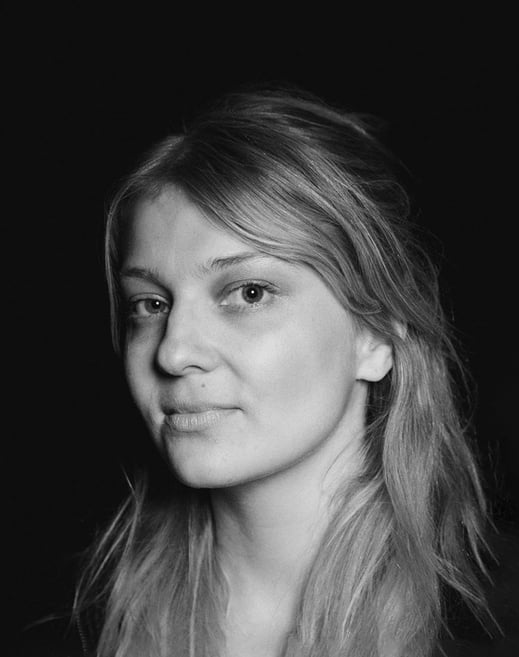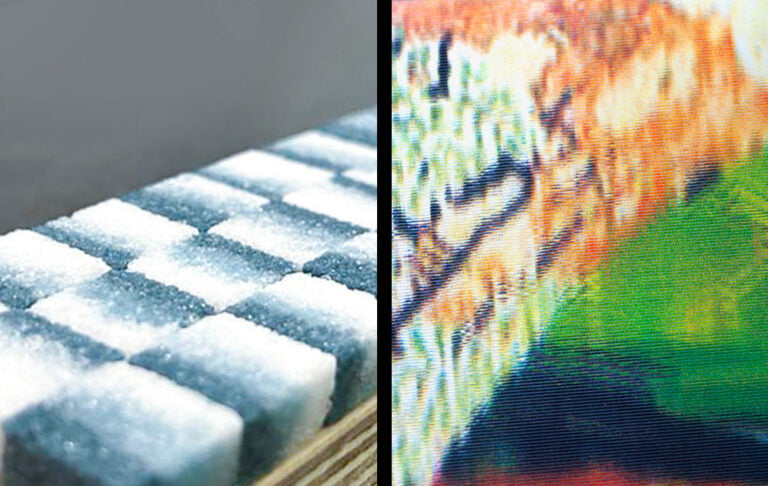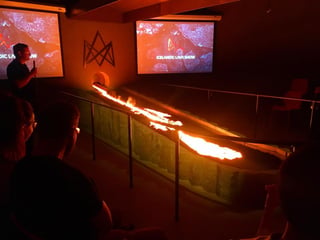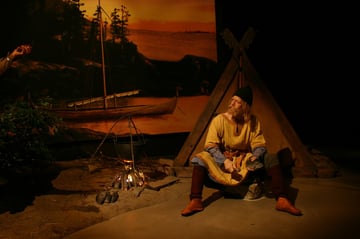On Saturday, January 27th, at 3 PM, two exhibitions will open at Listval Gallery on Hverfisgata 4. Hide & Seek featuring works by Thomas Pausz and Sugar Baptism featuring works by Ragnhildur Weisshappel.
THOMAS PAUSZ
HIDE & SEEK
Hide & Seek is an ecological fable following multiple narratives. We encounter fragments from the diary of an amateur wildlife photographer lost in Vatnsmýri, birds attempting to build nests in human architecture, and a fan of Sir David Attenborough. Through photography, collages and artifacts, Thomas Pausz portrays the struggles, hopes and failures of capturing images of wildlife: he tries to make his own camouflage to become invisible in nature, waits for the elusive birds, struggles with cameras, and sometimes loses the focus. The assemblages of images resulting from his experience resemble memories or dreams of other landscapes.

The ecological context of the works in Hide & Seek is the disappearance of the wild, and the contemporary feeling of solastalgia: a feeling of the strangeness of a landscape that we used to know, but do not recognize anymore.
An important form of our relation to landscape and wildlife is through images and art – and particularly photography. Pausz freely explores the history of the medium. Due to the long exposure times needed by the first cameras, the first romantic images of ´wild´ animals were actually staged with stuffed dead beasts. As camera technology evolved, photographers used ´photographic hides´, small camouflage tents where they could be invisible and capture their subjects. The scenography of Hide & Seek is inspired by these devices and soft architectures mediating between the bodies of humans and non-humans. Today despite the rapid loss of biodiversity, we produce and consume more and more spectacular high-resolution photography of wildlife.
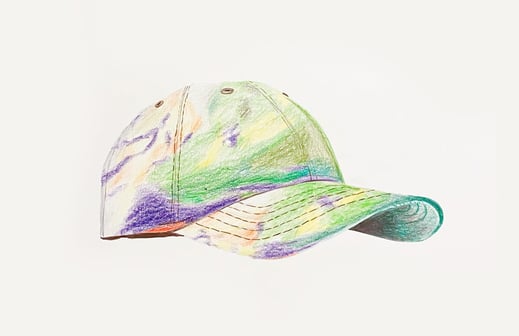
´A new breed of animals now surrounds humans – a species of vanishing animals, whose being is constituted by the state of disappearing. The modern animal became (through the technological image) a memory of the present.
(Akira Mizuta Lippit, Electric Animal)
Við erum vampírur sem sækjumst eftir myndum af hinu óspillta. Á sama tíma hönnum við sjálfstýrðar myndavélar á borð við fjarstýrðar myndagildrur til að ná stórfenglegum myndum af náttúrulífinu. Með þessum gildrum hverfur hið mannlega úr ljósmynduninni. Við hönnum okkar eigið hvarf og látum það i hendur hinna stafrænna tækja að standa augliti til auglitis við náttúruna. Með þessu móti er hætta á að fegurð upplifunarinnar glatist.
We are vampires who need images of wilderness. But at the time we are designing autonomous cameras such as remote-controlled photographic traps to get more extreme images of wildlife. These traps remove the human from the act of taking the photos. We are designing our own vanishing, and we are leaving the face-to-face with nature to digital devices. In order to get the perfect image, we might lose the beauty of the experience.
Thomas Pausz´s works in Hide & Seek reinterprets the tools and aesthetics of amateur wildlife photography to create a fictional landscape and a personal narrative.
THOMAS PAUSZ
Thomas Pausz is an artist and designer born in Paris and based in Reykjavík. Pausz holds an MA from the Royal College of Arts (UK) and a BA in Philosophy from Paris X University (France). In his practice, Pausz explores fictional ecosystems, using media and material experiments to propose alternative relations to the non-human environment. In 2023-2024, Pausz is a Stanley Picker Fellow in Art and Design in London. Recent projects include Haunted Ecologies at Stanley Picker Gallery, London; Interspecies Futures at Centre for Book Arts, New York; Nature in Transition, Shifting Identities at The Nordic House, Iceland; The Wildflower at Hafnarborg Museum, Iceland; The Swamp Pavilion at the Venice Architecture Biennale; Species Without Spaces at Atelier Luma & Istanbul Design Biennale; Food: Bigger than the Plate at the Victoria & Albert Museum, London UK and Out of the Sea at Passerelle Contemporary Art Centre Brest, France.
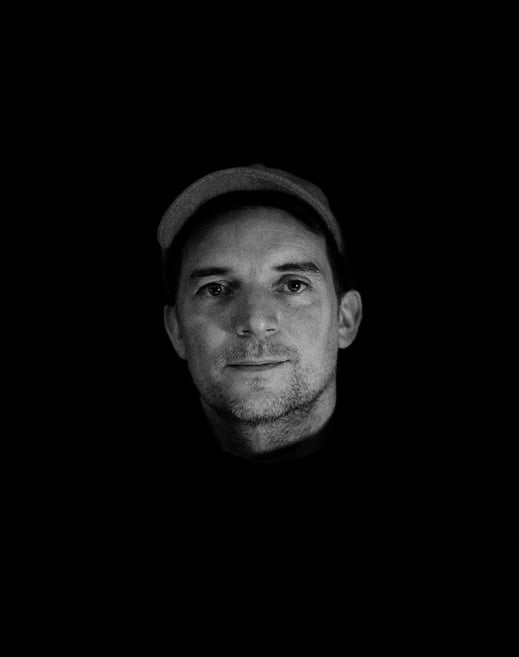
RAGNHILDUR WEISSHAPPEL
BABTISM BY SUGER
The exhibition Sugar Baptism featuring works by Ragnhildur Weisshappel presents artwork created from sugar cubes that she colors using a specific dipping technique. White-purified sugar cubes, all similar in shape and size, are delicately dipped into a mixture of paint and water. The cubes absorb the blend, and within seconds, the colors adhere to the sugar grains. The goal is to have the cubes semi-painted, with the artist in control of the process. Each sugar cube behaves in its own way, resulting in unique color patterns. The cubes are then arranged side by side, forming a composite whole from many individual sugar cubes.
The works in the exhibition touch on ideas of quantum physics. In the realm of quantum physics, subatomic particles can exist in different states and even multiple states simultaneously. Particles like photons, electrons, protons, and neutrons can behave as waves, like sound, and as particles, like grains. This fascinating behavior means that the state of a quantum system cannot be precisely measured, only the probabilities and potential states, determined ultimately by chance. Unlike classical physics, where objects have measurable and fixed properties, quantum physics relies on probabilities.
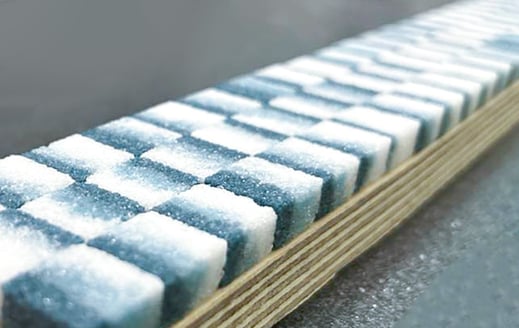
One artwork in the exhibition measures 119 x 119 cm and contains 6400 colored sugar cubes. The potential arrangements of 6400 cubes involve a number starting with 1 followed by 21,592 zeros. What happens if you rotate the cubes? The possibilities multiply and become astronomical. Introduce more colors, and the possibilities, and consequently the possibilities in potential artworks, become almost endless. It’s natural for the mind to struggle with the idea of such magnitudes. It seems too chaotic. There must be one way better than another.
Ragnhildur’s work, and that of other artists, revolves around making decisions. She must find the best possible options to discover her truth in artistic creation. How challenging is that when the potential choices are infinitely many? Are some options better than others? The answer is yes. Some possibilities are better and more intriguing in art. If not, all paintings in the world would be unpainted, just as all music would be silent, books unwritten, and films dark. Without better choices, the Universe itself would be empty, and non-existent.

Ragnhildur always dwells in possibilities and contemplates different paths. It is a great fortune and privilege to have the ability to do so, and we should respect and preserve it. Without diverse perspectives and imagination, life would be purposeless, even dangerous. In the sugar cubes artworks, art emerges in the clouds of endless possibilities. Ragnhildur manages to activate our imagination to see inexhaustible possibilities and experience freedom within them. With such interactivity, art may crystallize.
RAGNHILDUR WEISSHAPPEL
Ragnhildur Weisshappel studied art in Iceland and France. She works in all media and uses it as a tool to translate from one thing to another. She has partaken in numerous group exhibitions in museums and exhibition spaces in Iceland and abroad. Ragnhildur lives and works in Svarfaðardalur, Iceland.
